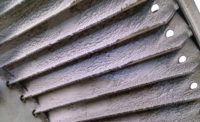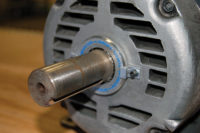Motors make the HVAC world go ‘round — or, at the very least, in the HVAC business, they make the air go ‘round. And while some motors last for many years without any issues, others stop working prematurely, leading to frantic service calls from customers who no longer have heat or air conditioning due to a fried motor.
Motor failures can be attributed to a number of causes. To minimize motor imperfections, contractors must stress the importance of a comprehensive inspection, properly identify and diagnose the root cause of the deficiency, and be able to explain the failure to customers in terms they’ll understand.
Causes of Motor Failure
Many different conditions can cause motor failure in HVAC equipment, but the most common is overheating, which can be attributed to a variety of different factors.

|
| Variable-frequency drives (VFDs) have helped to reduce the number of motor failures that are the result of overheating and voltage irregularities. (Photo courtesy of Flir Systems Inc.) |
Rich Morgan, president, Magic Touch Mechanical Inc., Mesa, Ariz., said that in his experience, dirt is often the culprit, as is improper ventilation. “Dirty fan compartments and buildup on fan squirrel cages causes fan motors to work harder and hotter,” he explained. “We also see motor failures in the residential market caused by high static pressures from undersized, restricted, or poorly designed ducting.”
Leandro Tarragona, application engineer at Danfoss, agreed that dirt is a primary contributor to motor overheating and failures. “Historically, and before the widespread use of variable-frequency drives [VFDs], the most common motor failures resulted from overheating, which is most often caused by voltage irregularities, and mechanical issues induced by dirt and moisture,” Tarragona said, adding that VFDs have helped to reduce the number of motor failures that are the result of overheating and voltage irregularities.
Barbara Dean-Hendricks, director of product marketing at Honeywell, listed full-load amps applied to the motor without a soft start, frequent stop/start cycles, and a current spike to the motor as three common causes of motor failure. “VFDs can help reduce all three of these common issues with HVAC equipment motors,” she added.
Jerry Krych, manager, AAH Warranty Service at Daikin Applied, said belts can shorten a motor’s lifespan if they are too tight, even if the motor has a VFD. He added that overloading the motor and not properly lubricating the bearings can also lead to motor failure.
Mike Wolf, product manager, fan and vent, Greenheck Fan Corp. agreed that overloading the motor can cause it to overheat and fail prematurely. “Motor life is greatly affected by temperature — for every 10˚C increase in motor temperature above its rating, the life of the motor is cut in half,” he said.
Diagnosing Motor Failure
Figuring out what caused a particular motor to fail takes troubleshooting skills, patience, and the proper tools. “A multimeter is the tool that proves a motor failure diagnosis,” Morgan said. “However, it takes a technician to dig deeper and do a thorough inspection of the entire system and its components to determine what caused the failure of the motor in the first place.”
Krych agreed that an inspection is necessary to rule out any other issues that may exist. He recommended checking the contactors, lugs, wires, wire nuts, overload settings, and bearing lubrication, as well as using a multimeter to test the motor.
Tarranoga said using a clamp meter on a motor that is still able to run can reveal current imbalances in the various phases. He added that if the motor is connected to a VFD, the VFD itself can be a good measurement tool due to built-in alarms and warning systems that will signal if there is a problem with the motor.
Sam Ruback, product manager at FLIR Systems Inc. said the FLIR CM83 power clamp excels at pinpointing problems related to motors, drive controllers, and internal power issues. “Harmonics mode on the FLIR CM83 is especially useful for motor analysis because it enables troubleshooters to view the third harmonics to determine if there’s an internal power issue that needs to be tracked down and addressed,” he said.
Repair or Replace
For many smaller motors in HVAC equipment, repairing the motor is often not the most cost-effective option. “In residential and light commercial equipment, the motor is always replaced, as it’s just not cost-effective to fix a smaller motor,” Morgan explained.
Hank Bloom, owner, Environmental Conditioning Systems, Mentor, Ohio, agreed that smaller motors are often not worth the time or effort necessary to fix them.
“Typically, it is best to replace motors,” Bloom said. “New motors have a warranty, are more efficient, take less time to replace, and are rated for VFD use.”
However, on motors that are 25 hp or larger, “if the bearings have failed without causing winding failure, you can replace the bearings,” Bloom said. “We have replaced bearings on large motors in remote mechanical rooms — that is when it makes sense.”
Preventing Motor Failure
Simply replacing or fixing a motor is not necessarily the final step on a service call. If the root cause of the failure has not been addressed, such as improper ventilation or sizing, chances are the new motor will fail, too.
To help prevent motor failure, Wolf said the motor size must match the load and design. He added that a VFD should only be used with a VFD-rated motor and suggested that the length of wire from the VFD to the motor should not exceed the recommended length.
“Cleaning the vent areas of open motors with a vacuum will also increase airflow for cooling the motor,” Wolf said. “Wiping with a rag can drive debris into the motor and cause greater issues.”
Both Morgan and Bloom stressed the importance of routine maintenance and maintenance contracts.
“Do routine preventive maintenance,” Bloom said. “The most important step is having a technician that is persistent during inspection.”
“After replacing the fan motor and whatever contributed to its failure, it is usually easy to explain to a customer that this type of expense can be avoided going forward by cleaning and maintaining the equipment,” Morgan said.
Dean-Hendricks agreed that maintenance is important, adding that a soft start with a VFD can help keep a motor working longer. Tarranoga added that a mechanically sound installation is also critical to avoid premature bearing failure.
“With VFD-connected motors, the MOL [motor overload] setting equivalent typically is a parameter, so a well-parameterized drive is critical,” Tarranoga said. “A clamp meter check always is recommended, even though most VFDs will show motor current.”
Wolf said using a permanent magnet electronically commutated motor (ECM) with built-in variable-speed control, like Greenheck’s Vari-Green® motor, can help eliminate many of the issues caused by using single-speed motors, as well as shaft current issues sometimes caused by VFDs. “Solid-state speed controllers can be added to single-phase ac motors to get some turn down, but their efficiency, which wasn’t good to begin with, suffers greatly,” he said.
Jim Connell, vice president of sales, Airxchange Inc., said the company uses ECM motors in its energy-recovery products to help prevent premature motor failures. “ECM motors are more reliable and use less energy than traditional ac motors and drives,” he added.
Bloom said he occasionally finds a motor that has been misapplied, which has led to repeat failures. Again, he stressed the importance of maintenance contracts. “There is no substitute,” he said.
And for those who wish to hone their motor troubleshooting skills, Morgan had some advice: “There’s a huge amount of training available for diagnosing motor failures and causes of motor failures. I highly recommend taking as many classes as possible, as often as possible.”
Publication date: 12/9/2013
Want more HVAC industry news and information? Join The NEWS on Facebook, Twitter, and LinkedIn today!





